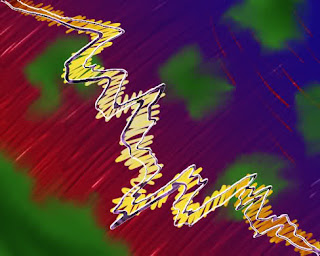I figure that there is no better way to show where I'm going than to show where I come from. The following are various drawing and sketches from the far past, with roughly-estimated dates. These were largely from when I was regularly drawing in middle & high school, with little to no formal art education.
At this stage in my artistic development, the majority of my drawings consisted of simple penciled line art copied directly from other simple line art. I focused mostly on main-stream cartoons, with a heavy emphasis on Disney movies.
Age 10-12
There was little investment of time, and zero planning on composition, etc. I started with a line, finished with a line, and didn't bother to flesh out forms, placement, or proportion.
You can easily witness my transition from preschematic/schematic drawing (which implies heavily on the use of "symbols" when drawing) to more dawning/pseudorealism. I still focused on symbols, but put more emphasis on trying to capture the "trueness" of a subject. Value and form were conscious ideas in my mind, but I didn't quite know how to execute those ideas. My drawing is still very linear.
At this point, many of my images are attempts to copy from how-to-draw style books, but lacked emphasis on form, instead copying from the finished images. Lines are still very present.
I understood that mastering shadow and form would greatly improve my artwork, but lacked the effort or ability to move past rushed sketches indicating that I could mimic, but not really understand.
Age 13-16
My send of proportion and relationships improved as far as human faces go, but the style is clearly linear. The drawing are still very symbolic and follow defined schemata, though they tend to follow a more "realistic" schema (particularly for noses and mouths).
There is still a heavy emphasis on cartooning. The ideas are unoriginal copies, but the concept of characters being made of larger shapes fleshed out with details finally clicked. Light outlining to define shape and proportion are evident.
I also grasped how line could alter the style and appearance of these characters, and experimented with bold and contrasting line.
I began to make the connection between taking my time and a more satisfying result. Most of my artwork was copied from other artists, but succeeded in developing a more personal style.
My interested in studying art and drawing increased at this point. I understood the importance of studying anatomy/perspective/form, etc at this point, but wasn't sure what that meant.
I read books on the subject, mimicked what I saw, but wasn't sure how that would translate into creating art of my own.
I could copy what I saw, and transitioned fluidly between linear and less-linear drawing, but wasn't really absorbing what I was learning. There were improvements in my drawing as I became more skilled with controlling a pencil, but many of my drawing lessons didn't apply when I attempted to create original artwork.
As can clearly be seen with the unusual placement of the joints in the above photo.
Age 16-20
At this point I began doing simply cartooning for the high school paper, scanning in lineart and editing it on the computer. These cartoons were my own personal style, not copied from other artists.
I developed a more distinct style, and tried to incorporate more detail and texture into my work. I still had a very two-dimensional style, but there were clear improvements.
My work was a little bit all-over-the-place these years, moving between cartooning, fantasy, elaborate doodles, and psuedorealism. Most of my work wasn't kept in a designated sketchbook at this point, and was lost over time.
Many of my drawings were based in fantasy...
... but there was an interest in realism, with many improvements over my previous drawings.
Digital Art Age 16-20
At some point in high school, I got a digital tablet and experimented with art on the computer. My development was similar to my drawing--- originally focusing heavily on lines, with poorly-executed shading and form added as an afterthought.
I knew what good art consisted of, but couldn't figure out how to implement it on my own.
I could occasionally come up with something passable as far as form went, but other elements and my composition were weak.
I did learn how to use digital tools to convey mood and achieve some interesting effects.
My lines improved, but most of my artwork was unfinished and consisted mostly of rough sketches.
Or decent drawings, with horrible digital effects detracting from the whole.
I also experimented with digital photo editing.
And more abstract concepts.
So there is obvious improvement, but plenty to learn as far as learning to see artistically, and learning to draw more than just imitations of other's work.




























Post a Comment